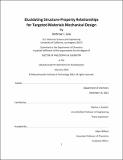Elucidating Structure-Property Relationships for Targeted Materials Mechanical Design
Author(s)
Lew, Andrew J.
DownloadThesis PDF (14.94Mb)
Advisor
Buehler, Markus J.
Terms of use
Metadata
Show full item recordAbstract
The ability to control mechanical properties has been of interest since time immemorial. Advancements in understanding the connection between structure and property has allowed for the intelligent design of materials with specific, desired properties. However, this task is immensely non-trivial due to the vast complexity of structure-property space. While nothing theoretically prevents the acquisition of materials with unprecedentedly extreme or precisely tuned mechanical properties, in practical terms many of our current strategies for materials design run up against intractable limits of time and resources. As a result, much of the exciting potential for nanotechnology, bioinspired structures, and hierarchical architectures remains unfulfilled.
In this dissertation, we leverage three ways of clarifying structure-property space for the effective design of materials with targeted mechanical properties. We start by taking inspiration from nature, leveraging structures that have manifest over millions of years of evolution as a basis for further design, to experimentally obtain novel hierarchical nanomaterials with extreme mechanical properties. We subsequently use physics-based molecular simulations to interrogate precise mechanisms underlying some of the most mechanically robust materials in nature, focusing specifically on biomineral fracture. We then utilize modern advances in machine learning to enhance our exploration of structure and property, treating first the problem of crystalline fracture and subsequently other mechanical properties of compliance and buckling in a material-agnostic manner.
Finally, the combination of all three approaches in concert allows for a farther-reaching design paradigm than limiting ourselves to any single perspective in isolation. As a result, we are able to achieve inverse design across a variety of structure-property spaces, from the controlled fracture of graphene, to the non-destructive characterization and design of hardness, and the development of hierarchical materials with specific, experimentally verified, stress strain behavior. Importantly, the strategy employed here is scalable across structures and properties, and will compound in efficacy with further advancements in key fields like additive manufacturing, computational simulation, and artificial intelligence.
Date issued
2023-02Department
Massachusetts Institute of Technology. Department of ChemistryPublisher
Massachusetts Institute of Technology